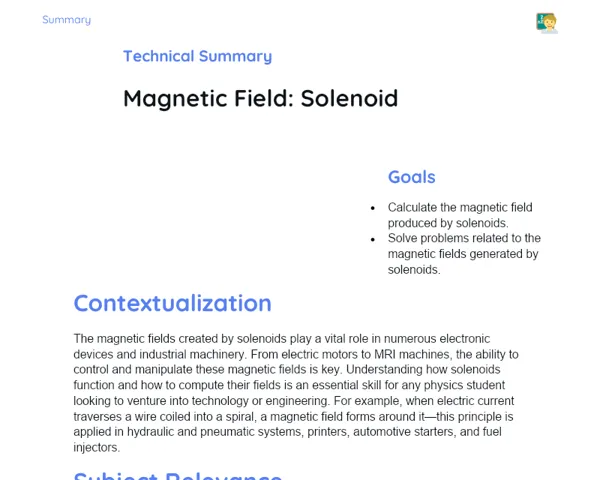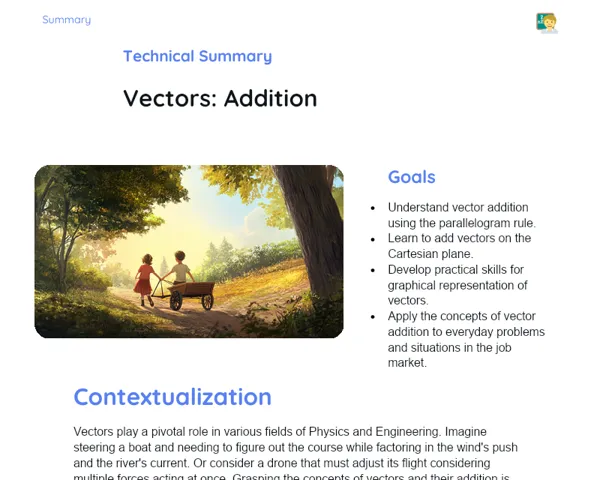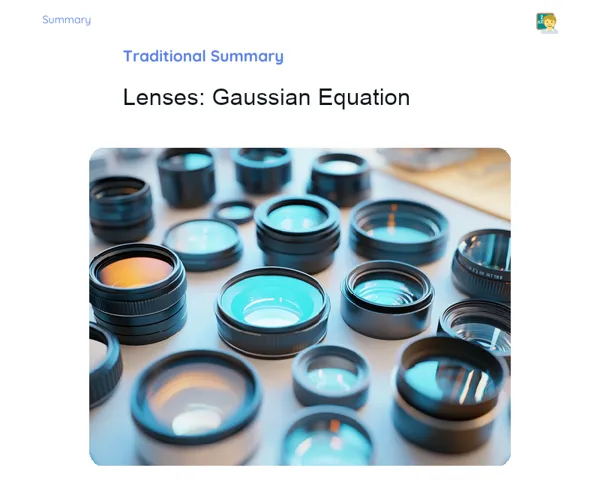Summary Tradisional | Work: Power and Speed
Contextualization
Understanding power in physics is crucial for grasping how energy moves and gets used in various systems. Power is simply the speed at which work gets done or how much energy is transferred over time. Simply put, higher power means work gets done faster. The formula P = F * v, where P is power, F stands for force, and v represents velocity, helps us calculate power in scenarios where force and velocity move in the same direction. This idea is widely applicable in numerous fields, from engineering to sports, and it significantly influences the efficiency and effectiveness of the systems we encounter in our daily lives.
In the realm of machines and engines, understanding power is vital. For instance, the power of cars and bikes is often measured in horsepower (HP), with one horsepower being roughly equivalent to 746 watts. By knowing how power is generated and used, we can evaluate energy efficiency and the environmental impact of our vehicles. Moreover, in sports, the correlation between power and speed can greatly impact an athlete's performance, such as in cycling or swimming, where the applied force and resultant speed are critical for success.
To Remember!
Concept of Power
Power measures the rate at which work gets done or energy gets transferred. It’s measured in watts (W), where 1 watt equals 1 joule per second (1 W = 1 J/s). This means a device with a power output of 1 watt is transferring 1 joule of energy every second. Grasping the concept of power is critical for both physics and engineering, as it quantifies how rapidly machines and systems operate.
You can observe power in many contexts, from how motors and machines work to how athletes perform. For instance, in a car engine, power shows how quickly the engine transforms fuel energy into motion. In sports like cycling, power illustrates how swiftly an athlete converts muscular energy into movement, thus affecting their performance.
It’s worth noting that power relies not just on how much work is accomplished, but also on the time it takes to complete that work. Therefore, two engines could do the same amount of work, but their powers can differ if one takes less time than the other. This fact highlights why power is a critical measure of efficiency in various systems.
-
Power is the rate of doing work or transferring energy.
-
Measured in watts (W), where 1 W = 1 J/s.
-
Vital for quantifying how quickly machines and systems function.
Power Formula: P = F * v
The equation P = F * v links power to the force applied and the velocity of a moving object. Here, P signifies power, F represents the applied force (in newtons), and v stands for velocity (in meters per second). This relationship holds true when the force and velocity move in the same direction, meaning force is applied directly in the direction of motion.
This formula proves crucial in numerous practical scenarios. For example, in vehicles, the engine's power is estimated by multiplying the force the engine applies to the wheels by the speed of the vehicle. In the sports arena, the power exerted by an athlete is also determined by multiplying the applied force, such as the push on a cycle pedal, by the speed they reach.
Comprehending this formula allows engineers and scientists to enhance machine efficiency by modulating force and speed to achieve optimum power. For instance, during engine design, engineers can apply this formula to determine the best force and speed combination for maximizing energy efficiency.
-
P = F * v, where P is power, F is force, and v is velocity.
-
The equation applies when force and velocity share the same direction.
-
Essential for calculating power in vehicles and sports.
Difference Between Work and Power
Work and power, while related, are distinct concepts in physics. Work refers to the energy transferred by a force acting on a body over a distance. It’s quantified in joules (J) and can be computed using W = F * d * cos(θ), where W is work, F is force, d is distance, and θ is the angle between the force and movement direction.
Conversely, power indicates how fast that work is completed or energy is transferred. While work measures the overall energy transferred, power evaluates the quickness of that transfer. This means two processes completing the same work can have dissimilar powers if one takes less time.
Understanding work versus power is essential for their effective application in real-world scenarios. For instance, when determining an engine's efficiency, simply knowing the work done isn’t sufficient; understanding the power involved is crucial for gauging how quickly it executes that work and assessing its efficiency.
-
Work is the energy transferred by a force over a distance.
-
Power is the rate of performing work or energy transfer.
-
Two processes can exhibit different powers while doing the same work, depending on the time consumed.
Practical Applications and Examples
Grasping power and its interplay with force and velocity has numerous practical applications. In engineering, it aids in designing efficient motors and machinery. For instance, when crafting a car engine, engineers utilize P = F * v to determine the power required to reach specific speeds with a predefined force. This optimizes the vehicle's performance and energy efficiency.
In athletics, power serves as a pivotal performance gauge. Athletes like cyclists and runners employ the power concept to enhance their training regimes. A cyclist may, for instance, use power meters to track the force exerted on the pedals and their attained speed, tweaking their training to elevate their power output.
Moreover, power is fundamental in industrial environments, where machines must operate optimally. Grasping how to adjust force and velocity to attain the necessary power allows engineers to enhance industrial operations, cut costs, and boost productivity.
-
Utilized to design efficient motors and equipment.
-
Key for measuring and enhancing athletic performance.
-
Crucial for optimizing industrial workflows and boosting productivity.
Key Terms
-
Power: Rate at which work is done or energy is transferred, measured in watts (W).
-
Work: Energy transferred by a force acting over a distance, expressed in joules (J).
-
Formula P = F * v: Connects power, force, and velocity, where P is power, F is force, and v is velocity.
-
Force: Interaction causing a change in motion, measured in newtons (N).
-
Velocity: Rate of change of position of an object, measured in meters per second (m/s).
Important Conclusions
In this lesson, we delved into the idea of power, which is the speed at which work is done or energy is transferred. We recognized that the formula P = F * v connects power with the applied force and velocity, serving as an invaluable tool for assessing system efficiency across various domains, including engineering and sports. We also discussed the differences between work and power, highlighting that while work gauges the total energy transferred, power focuses on the speed of that transfer, which is vital for measuring machine and engine efficiency.
Comprehending these concepts is essential for numerous practical applications. In engineering, it facilitates the enhancement of motor and machine functionality. In sports, it aids in improving athlete performance. Additionally, it plays a crucial role in industrial practices, where energy efficiency can be maximized by fine-tuning force and velocity to achieve the ideal power.
We emphasized the importance of understanding the ties between power, force, and velocity not just in theoretical physics but also in real-world applications that shape our everyday lives. By grasping these concepts, students will be more equipped to tackle challenges in technology, industry, and sports, enabling them to contribute to creating more efficient and sustainable solutions.
Study Tips
-
Review the formula P = F * v and practice solving power calculations in various scenarios, such as in vehicles and sports.
-
Examine the distinctions between work and power, focusing on practical examples showcasing their applications in real-world situations.
-
Investigate power's practical applications in engineering and sports, exploring real-world cases where performance and energy efficiency are enhanced based on these principles.



